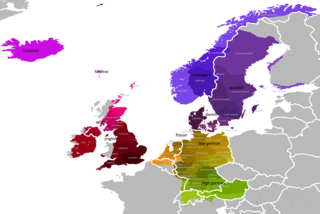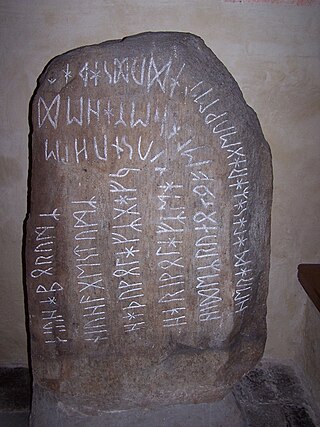
The Germanic languages are a branch of the Indo-European language family spoken natively by a population of about 515 million people mainly in Europe, North America, Oceania and Southern Africa. The most widely spoken Germanic language, English, is also the world's most widely spoken language with an estimated 2 billion speakers. All Germanic languages are derived from Proto-Germanic, spoken in Iron Age Scandinavia and Germany.
In Germanic cosmology, Midgard is the name for Earth inhabited by and known to humans in early Germanic cosmology. The Old Norse form plays a notable role in Norse cosmology.
Old English, or Anglo-Saxon, is the earliest recorded form of the English language, spoken in England and southern and eastern Scotland in the early Middle Ages. It developed from the languages brought to Great Britain by Anglo-Saxon settlers in the mid-5th century, and the first Old English literary works date from the mid-7th century. After the Norman Conquest of 1066, English was replaced, for a time, by Anglo-Norman as the language of the upper classes. This is regarded as marking the end of the Old English era, since during this period the English language was heavily influenced by Anglo-Norman, developing into a phase known now as Middle English in England and Early Scots in Scotland.

Yule is a winter festival historically observed by the Germanic peoples that was incorporated into Christmas during the Christianisation of the Germanic peoples. In present times adherents of some new religious movements celebrate Yule independently of the Christian festival. Scholars have connected the original celebrations of Yule to the Wild Hunt, the god Odin, and the heathen Anglo-Saxon Mōdraniht. The term Yule and cognates are still used in English and the Scandinavian languages as well as in Finnish and Estonian to describe Christmas and other festivals occurring during the winter holiday season. Furthermore, some present-day Christmas customs and traditions such as the Yule log, Yule goat, Yule boar, Yule singing, and others may have connections to older pagan Yule traditions.

Æsir or ēse are gods in Germanic paganism. In Old Nordic religion and mythology, the precise meaning of the term "Æsir" is debated, with it being able to refer to both the gods in general or specifically to one of the main families of gods, in contrast to the Vanir, with whom they waged war, ultimately leading to a joining of the families. The term can further be used to describe local gods that were believed to live in specific features in the landscape such as fells. In the Old English Wið færstice, the Ēse are referred to, along with elves, as harmful beings that could cause a stabbing pain, although exactly how they were conceived of by the author of the text is unclear.
Völsung is a figure in Germanic mythology, where he is the eponymous ancestor of the Völsung family, which includes the hero Sigurð. In Nordic mythology, he is the son of Rerir and was murdered by the Geatish king Siggeir. He was later avenged by one of his sons, Sigmund, and his daughter Signy, who was married to Siggeir.

The Norsemen were a North Germanic linguistic group of the Early Middle Ages, during which they spoke the Old Norse language. The language belongs to the North Germanic branch of the Indo-European languages and is the predecessor of the modern Germanic languages of Scandinavia. During the late eighth century, Scandinavians embarked on a large-scale expansion in all directions, giving rise to the Viking Age. In English-language scholarship since the 19th century, Norse seafaring traders, settlers and warriors have commonly been referred to as Vikings. Historians of Anglo-Saxon England distinguish between Norse Vikings (Norsemen) from Norway, who mainly invaded and occupied the islands north and north-west of Britain, as well as Ireland and western Britain, and Danish Vikings, who principally invaded and occupied eastern Britain.

Wyrd is a concept in Anglo-Saxon culture roughly corresponding to fate or personal destiny. The word is ancestral to Modern English weird, whose meaning has drifted towards an adjectival use with a more general sense of "supernatural" or "uncanny", or simply "unexpected".

Blót or geblōt are religious ceremonies in Germanic paganism that centred on the killing and offering of an animal to a particular being, typically followed by the communal cooking and eating of its meat. Old Norse sources present it as a central ritual in Old Nordic religion that was intimately connected with many wider aspects of life. Large blót are often described as taking place in halls, organised by the rulers of the region who were expected to carry out the practice on behalf of the people. Blót were central to the legitimacy of rulers and Christian rulers refusing to hold them were at times replaced by more willing alternatives and driven out of the land. Smaller, household blót were sometimes recorded as being led by women. Beyond strengthening legitimacy for the ruling elites, the performance of blót was often in order to ensure the fertility of the land, a good harvest and peace, although they are also recorded as being performed for divination or to achieve desired results in legal matters.
The early Germanic calendars were the regional calendars used among the early Germanic peoples before they adopted the Julian calendar in the Early Middle Ages. The calendars were an element of early Germanic culture.

*Walhaz is a reconstructed Proto-Germanic word meaning 'foreigner', or more specifically 'Roman', 'Romance-speaker' or '(romanized) Celt', and survives in the English words of 'Wales/Welsh' and 'Cornwall.' The term was used by the ancient Germanic peoples to describe inhabitants of the former Roman Empire, who were largely romanised and spoke Latin languages. The adjectival form is attested in Old Norse valskr, meaning 'French'; Old High German walhisk, meaning 'Romance'; New High German welsch, used in Switzerland and South Tyrol for Romance speakers; Dutch Waals 'Walloon'; Old English welisċ, wælisċ, wilisċ, meaning 'Brythonic'. The forms of these words imply that they are descended from a Proto-Germanic form *walhiska-.

Grendel's mother is one of three antagonists in the anonymous Old English poem Beowulf, the other two being Grendel and the dragon. Each antagonist reflects different negative aspects of both the hero Beowulf and the heroic society that the poem is set in. Grendel's mother is introduced in lines 1258b to 1259a as: "Grendles modor/ides, aglæcwif".

Landvættir are spirits of the land in Old Nordic religion, later folk belief and modern Heathenry. They are closely associated with specific locations and their wellbeing is presented as being required for the land they inhabit to be fruitful. In Old Norse sources, they are depicted as being potentially harmful and capable of driving away unwanted individuals and capable of being frightened through human actions such as usage of carved figureheads on ships or níðstangs. Good relationships between humans and landvættir were believed to be fostered through acts like leaving out food for them however upon the establishment of the church, the practice was labelled heretical and explicitly forbidden in the Norwegian Gulating law codes.
The term man and words derived from it can designate any or even all of the human race regardless of their sex or age. In traditional usage, man itself refers to the species or to humanity (mankind) as a whole.

The spear or lance, together with the bow, the sword, the seax and the shield, was the main equipment of the Germanic warriors during the Migration Period and the Early Middle Ages.
Sowilo (*sōwilō), meaning "sun", is the reconstructed Proto-Germanic language name of the s-rune.
Neorxnawang is an Old English noun used to translate the Christian concept of paradise in Anglo-Saxon literature. Scholars propose that the noun originally derives from Germanic mythology, referring to a "heavenly meadow" or place without toil or worries.
Ǣrra Līða was the Anglo-Saxon name for the month of June.

Trees hold a particular role in Germanic paganism and Germanic mythology, both as individuals and in groups. The central role of trees in Germanic religion is noted in the earliest written reports about the Germanic peoples, with the Roman historian Tacitus stating that Germanic cult practices took place exclusively in groves rather than temples. Scholars consider that reverence for and rites performed at individual trees are derived from the mythological role of the world tree, Yggdrasil; onomastic and some historical evidence also connects individual deities to both groves and individual trees. After Christianisation, trees continue to play a significant role in the folk beliefs of the Germanic peoples.












